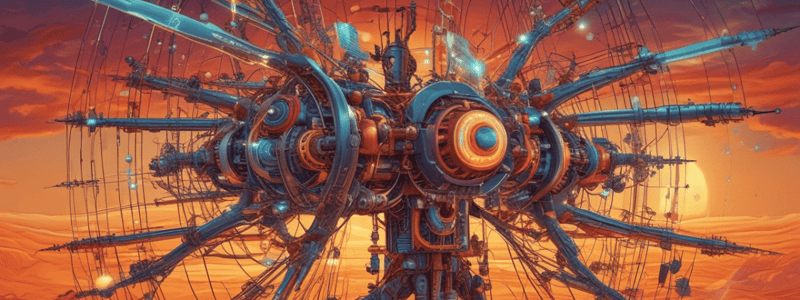Podcast
Questions and Answers
What is the physical quantity that is transferred when a force is applied and gets converted into kinetic energy of an object?
What is the physical quantity that is transferred when a force is applied and gets converted into kinetic energy of an object?
Energy
Which type of energy is associated with the position of an object in a gravitational field?
Which type of energy is associated with the position of an object in a gravitational field?
Gravitational potential energy
What is the unit of power?
What is the unit of power?
Watts (W)
What is the physical quantity that is equal to mass multiplied by velocity?
What is the physical quantity that is equal to mass multiplied by velocity?
What is the term used to describe a change in momentum?
What is the term used to describe a change in momentum?
Which fundamental principle states that energy can be converted from one form to another, but can never be created or destroyed?
Which fundamental principle states that energy can be converted from one form to another, but can never be created or destroyed?
What is the physical quantity that remains constant in a system if no external forces act on it?
What is the physical quantity that remains constant in a system if no external forces act on it?
What is the term used to describe the ability to do work to move an object?
What is the term used to describe the ability to do work to move an object?
What five quantities are used to describe the motion of an object with constant acceleration?
What five quantities are used to describe the motion of an object with constant acceleration?
How do you find the total distance travelled from a velocity-time graph?
How do you find the total distance travelled from a velocity-time graph?
What relationship exists between the time taken to accelerate and decelerate from rest?
What relationship exists between the time taken to accelerate and decelerate from rest?
Describe how velocity-time graphs can be used to infer acceleration.
Describe how velocity-time graphs can be used to infer acceleration.
Why is it beneficial to split the area under a velocity-time graph into simpler shapes?
Why is it beneficial to split the area under a velocity-time graph into simpler shapes?
What does it indicate about an object's motion when the area under a velocity-time graph is zero?
What does it indicate about an object's motion when the area under a velocity-time graph is zero?
Flashcards are hidden until you start studying
Study Notes
Energy
- Energy is the ability to do work to move an object, measured in Joules (J).
- Energy can be realised in many forms, including kinetic energy and gravitational potential energy.
- Kinetic energy is the energy an object has due to its velocity.
- Gravitational potential energy is the type of energy an object has due to its position in a gravitational field.
Work
- Work gets done when a force is applied and energy is transferred.
- Work is equal to a constant force multiplied by displacement.
- Work can also be written as an integral if the force is changing.
Power
- Power is the rate at which work is done, measured in Watts (W).
- Power can be calculated by replacing work done with force and displacement.
Momentum
- Momentum is ‘mass in motion’.
- Momentum is equal to mass × velocity and is measured in kg m/s.
- Any moving object has momentum.
Impulse and Momentum
- Impulse is a change in momentum.
Conserved Quantities
- There are two fundamental principles: conservation of energy and conservation of momentum.
- Conservation of energy states that energy can be converted from one form to another, but can never be created or destroyed.
- Conservation of momentum states that the total momentum of a system is constant if no external forces from outside the system act.
Equations of Motion
- Five important quantities describe an object's motion with constant acceleration: displacement (s), initial velocity (u), final velocity (v), acceleration (a), and time taken (t).
- Four equations in the formula book link these quantities together.
Velocity-Time Graphs
- Velocity-time graphs display information about an object's changing speed over time.
- They can show velocity, acceleration, and distance travelled.
- The area underneath a v-t graph represents the total distance travelled.
- To find the area, split the shape into triangles and trapezoids.
Acceleration and Deceleration
- If an object accelerates from rest in time t1 and decelerates back to rest in time t2, the ratio of the accelerations is equal to the ratio of the times.
Studying That Suits You
Use AI to generate personalized quizzes and flashcards to suit your learning preferences.




